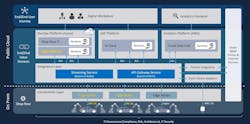How BMW Improves Interoperability with OPC UA and Edge Computing
Since the shift to Industry 4.0 first began, interoperability has been a central challenge. With the basis for the Industrial Internet of Things (IIoT) being the networking together of previously isolated pieces of equipment, standardized communication methods and protocols have been indispensable to its deployment.
The OPC Foundation’s OPC Unified Architecture (OPC UA) has long been at the forefront of providing such standardization. OPC UA is a machine-to-machine communication architecture that is openly available and compatible with multiple operating systems, programming languages, and platforms. OPC UA has allowed companies to ease the process of integrating disparate systems and pieces of equipment—often from various vendors—into a unified automation framework.
BMW, which presented at 2021’s OPC Day International online event, is one of many companies that reports it has been able to achieve substantial operational improvements through its use of OPC UA.
"OPC UA's standardization is a big benefit to achieving our goals,” said Julian Backhaus, head of DevOps team platform and solutions at BMW Group. “The information models and companion specifications available for robots and other pieces of equipment grant us interoperability, and when using public clouds and edge computing, security is a bigger topic for us than before too, and OPC UA also provides functionalities for that."
According to Backhaus, several problems existed across BMW’s facilities prior to its use of OPC UA for interoperability. For one, many different pieces of equipment, often from different vendors, were being used for various production steps. Not only that, but each vendor’s equipment often relied on proprietary standards. In addition, shop floors were using separate information technology (IT) systems for maintenance, quality inspection, and manufacturing execution systems (MES), resulting in a patchwork of stakeholders, none of which were able to easily exchange data with one another. Some facilities had even created their own plant-specific systems, which were not known to BMW’s central IT staff, resulting in even more barriers to synchronization and collaboration across multiple locations.
To solve these issues, BMW sought to use OPC UA to standardize the various custom interfaces individual facilities had developed with the goal of improving maintainability and allowing new applications to be scaled more easily across the entire enterprise. Backhaus noted that edge computing was also vital to BMW’s integration of OPC UA because it allowed high quantities of data being pulled from peripheral devices such as cameras to undergo preprocessing before being sent upward to the cloud. Moreover, the use of these edge gateways limited the amount of data leaving the plant floor, increasing security.
Backhaus also offered several specific use cases demonstrating how OPC UA, when integrated with edge computing, was able to facilitate concrete improvements to BMW’s workflow.
In one instance, an edge computer with an OPC UA connector ran a particle analysis model for environmental and dust analysis. Via the OPC UA interface, the edge computer was able to send commands to a programmable logic controller (PLC) to respond to changes in real time, while historical data was streamed upward to the cloud for further analysis. In another application, autonomous transport systems being used for material handling tasks where able to communicate with a PLC via OPC UA so that mechanical doors could be opened and closed for them when they passed from one area to the next.
To facilitate further adoption of OPC UA and other open standards, BMW is a part of the Open Manufacturing Platform alongside Microsoft, Bosch, ABB, PTC and several other industrial technology and services companies. Active working group topics at the Open Manufacturing Platform include reference architecture, IIoT connectivity, semantic data structuring, and autonomous transport system core services.
“The most important use case for OPC UA is machine connectivity. To get OPC UA utilized on the shop floor, you have to establish OPC UA as a standard for all new equipment. Equipment needs to have OPC UA servers on board so that it can be integrated into new applications,” Backhaus said. “After that, if you have to do some replacement or modification of your production equipment, you can do that much more easily if they’re already sitting on the same OPC UA standards and specifications.”

